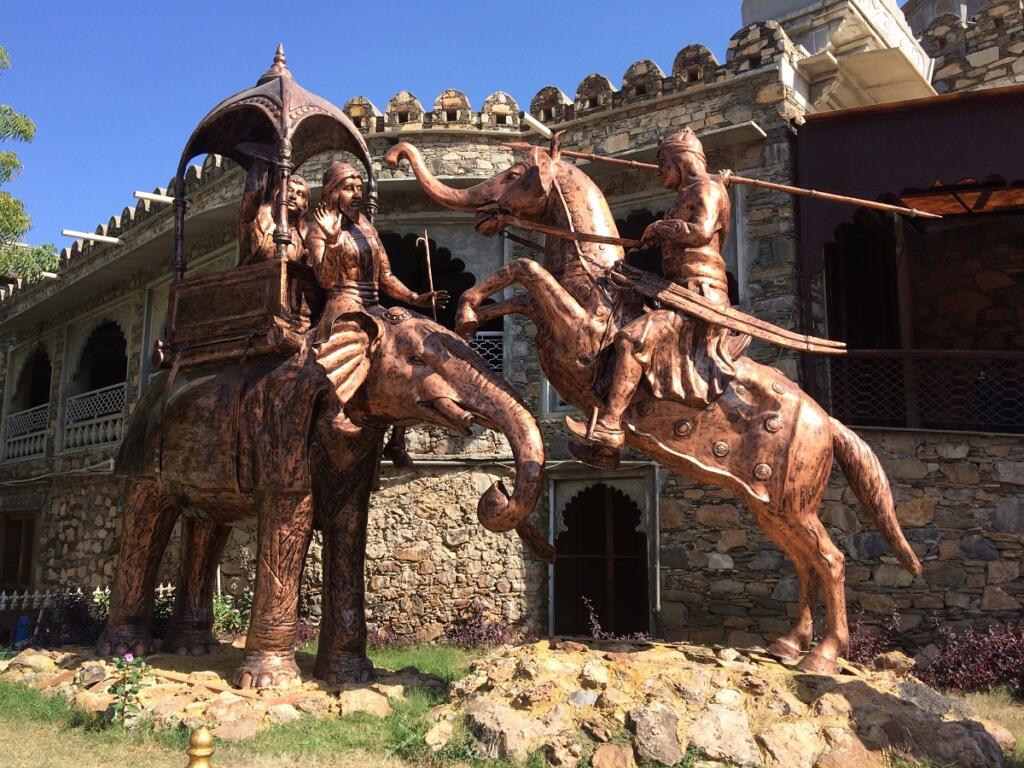Rajasthan’s gallant-king and warrior of Mewar, Maharana Pratap Singh is finally getting his due in history. The Archaeological Survey of India (ASI) will remove plaques at Rakta Talai in Rajasthan’s Rajsamand district that state Maharana Pratap’s forces retreated from the Haldighati battle. BJP MP Diya Kumari from Rajsamand had last month requested the union tourism and cultural minister to correct the plaques.
Speaking about the change in plaques, ASI Jodhpur circle superintendent Bipin Chandra Negi remarked “The plaques are over four decades old and in dilapidated condition. These plaques do not belong to the ASI as they were put up by the state’s tourism department. In 2003, this site was declared a centrally protected monument of national importance,”
Throughout the history books, the left-Marxist historians, soiling themselves for the Mughals have claimed that Pratap lost the Haldighati battle, despite having little to no evidence and relying on hearsay and anecdotal proofs to corroborate their claims.
However, a little history lesson never hurt anybody. The Battle of Haldighati was fought on June 18, 1576, which the now-removed plaque wrongfully mentioned being June 21, 1576.
Akbar, the then Mughal emperor was on a quest to conquer the entirety of India. Having annexed nearly every Rajput state and princely region in West India – the final frontier for Akbar’s grand plans passed through Udai Singh, the father of Maharana Pratap and his kingdom.
Akbar laid siege to Chittorgarh in October 1567. The Rajputs were surrounded and besieged by the Mughals. Udai Singh was forced to quit and the responsibility of defence was given to King Jaimal of Merta, who was killed during the battle. Udai Singh continued to stay in the forests of Aravalli till his death four years later.
Fast forward, Maharana Pratap took charge of the forces and two armies gathered to fight in the yellow-turmeric coloured soil of Haldighati, surrounded by the Aravalli mountain range. There’s no denying the fact that Pratap’s army was far outnumbered by Akbar’s army led by Man Singh I of Amber. Some estimates say that Pratap’s 3,000 strong force went toe to toe against the 80,000 soldiers of the Mughal Empire.
A fierce battle ensued and despite being small in numbers, the Rajputs more than made up for it with their valour and sheer indefatigable spirit. To revive the falling morale in the Mughal camp, a soldier spread the rumour that Akbar himself was taking the field for the battle.
Surrounded by the enemy fighting with a renewed vigour, Maharana Pratap didn’t stop fighting and threw a spear at Man Singh which, unfortunately, instead of hitting him, pierced the Mahouth of his elephant. Sensing the situation turning worrisome for his king who has fighting alone with the hundreds of Mughal soldiers, Man Singh Jhala of Badi Sadri, donned the visible emblems of Mewar’s ruler and created a diversion for Pratap to gather himself.
Jhala was eventually killed but Pratap managed to gallop away towards the surrounding hills. By the time, the light of Moon fell on the battlefield and brought an end to the four-hour-long battle, both armies had suffered casualties with Mughals receiving more hurt, due to the obvious bigger size of the army. While Pratap lost his beloved Chetak, he still remained in the fight.
Chandra Shekhar Sharma, an associate professor at Meera Girls College in Udaipur notes, “In the light of recent research and evidence, historians have come to the conclusion that Pratap’s army never retreated from the Battle of Haldighati. The war was won by Pratap.”
Man Singh might have stood with his army on the battlefield but they still could not breach Mewar as in the coming years, Maharana built himself up and regained control over most of his kingdom. It was a defeat for Akbar because despite holding the region to a siege for several years and fighting an all-out war, he could not conquer the tiny Rajput kingdom that spoilt his legacy.
According to a report by the lowdown, later, there would indeed be a lesser talked about, but a far more decisive battle at Dewair, which would see a crucial victory for Maharana Pratap against one of Akbar’s Mughal commanders, and the uprooting of 32 Mughal garrison posts in a single day.
History books and correction
As reported by TFI, after years of incessant demands from the general public asking the central government to rewrite the History books using authentic sources and evidence without adulterating them with the propaganda of some ill-motivated individuals, the centre has finally started the long-overdue exercise.
The GoI invited suggestions via email from the public for removing distortions in Indian History from the school textbooks. The deadline for sending suggestions to the government elapsed on July 15. Students, teachers, domain experts, or anyone having cogent knowledge about any particular subject of Indian history were invited to submit their work in English or Hindi to rsc_hrd@sansad.nic.in
GOI invites Suggestions For Removing Distortion in Our History Books pic.twitter.com/JJBdMdK1S2
— Megh Updates 🚨™ (@MeghUpdates) June 30, 2021
Read More: You wanted the Indian History to be re-written. Well, government wants you to rewrite it
The school history books currently in circulation across the country are replete with innumerable botched stories regarding the rich history of Bharat. There are several kingdoms and kings whose reigns are barely mentioned in the books. Freedom fighters who died giving their lives for the motherland are reduced to caricaturist figures while the likes of cruel, blood-hungry rulers like Tipu Sultan and Aurangzeb are glorified as the apostle of patriotism.
